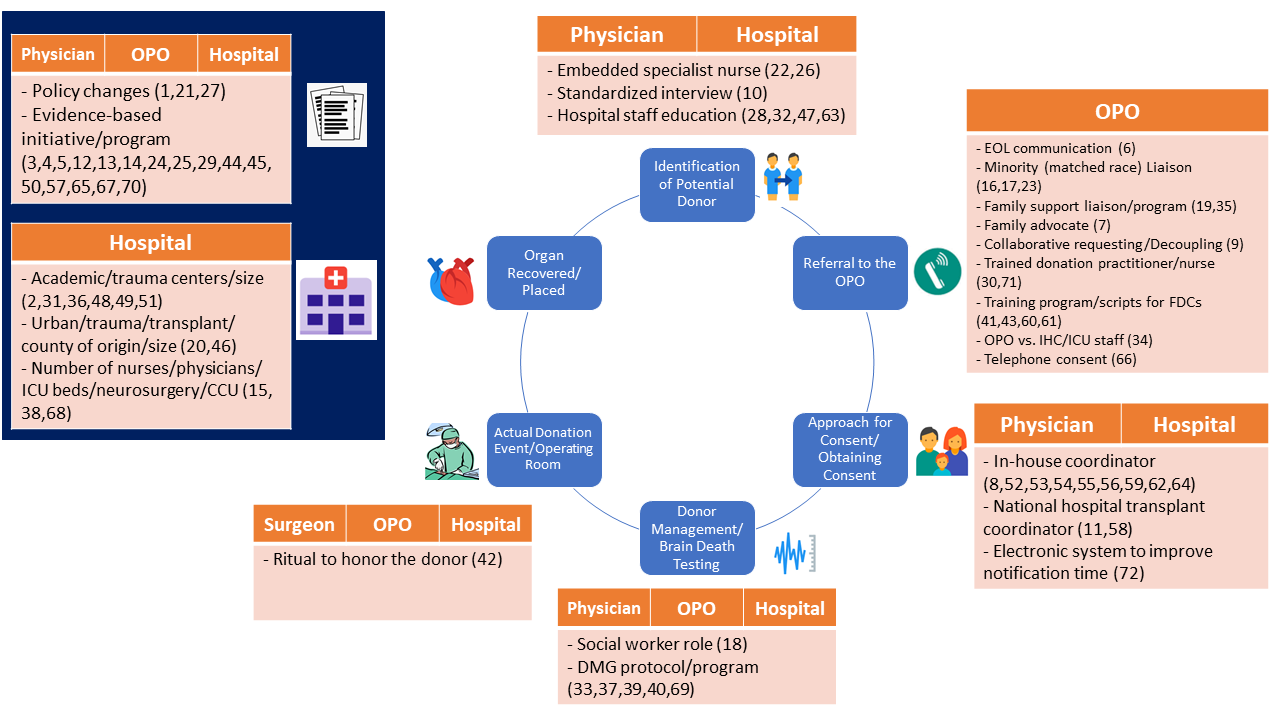Hospital-Level Metrics and Interventions to Increase Deceased Organ Donation: A Systematic Review
1Surgery, Brigham and Women's Hospital, Boston, MA, 2Brandeis University, Waltham, MA, 3Harvard Medical School, Boston, MA
Meeting: 2021 American Transplant Congress
Abstract number: 1250
Keywords: Donation, Resource utilization
Topic: Clinical Science » Organ Inclusive » Deceased Donor Management and Intervention Research
Session Information
Session Name: Deceased Donor Management and Intervention Research
Session Type: Poster Abstract
Session Date & Time: None. Available on demand.
Location: Virtual
*Purpose: The shortage of transplantable organs available for the ever-growing transplant waiting list is well-described. Efforts to ameliorate this have predominantly focused on improving processes and interventions at multiple levels in the organ donation process, but no comprehensive review of hospital-level factors exists. We undertook a systematic review of the literature to better understand what is known and what is not known about hospital-level factors associated with successful organ donation.
*Methods: We searched four electronic databases (PubMed, Embase, CINAHL, Web of Science, Health Business Elite, and Google scholar) and conference abstracts for articles on any hospital-level factors associated with the final outcome of organ donation (PROSPERO CRD42020187080). Editorials, letters to the editor, and reviews without original data were excluded. Our main outcomes were conversion rate, donation rate, number of organs recovered, number of donors, and consent rate.
*Results: Our search yielded 2,203 studies, and after a thorough assessment, 72 articles were included in this systematic review. Studies were thematically categorized into 1) Hospital-level interventions associated with metrics of organ donation; these included patient- and family-centric measures (i.e. standardized interviews, collaborative requesting and decoupling, and dedicated in-house coordinators), and donor management goals that significantly increased conversion rates by up to 64%; 2) Hospital-level multi-stage programs/policies; which increased consent rates between 30 and 50%; and 3) Hospital characteristics and qualities; being an academic center, trauma center and larger hospital correlated with higher consent and conversion rates. Figure shows the contribution of these studies at each step in the donation process.
*Conclusions: There is a lack of well-designed studies on hospital-level factors and interventions associated with organ donation. The use of thoughtful, patient- and family-centric approaches to consent generally is associated with more organ donors. Future work can build on what is known about the hospital role in organ donation to first collaborate with OPOs, and then to use this knowledge and collaboration to improve OPO performance.
To cite this abstract in AMA style:
Castillo-Angeles M, Li G, Bain P, Salim A, Adler JT. Hospital-Level Metrics and Interventions to Increase Deceased Organ Donation: A Systematic Review [abstract]. Am J Transplant. 2021; 21 (suppl 3). https://atcmeetingabstracts.com/abstract/hospital-level-metrics-and-interventions-to-increase-deceased-organ-donation-a-systematic-review/. Accessed January 8, 2026.« Back to 2021 American Transplant Congress

